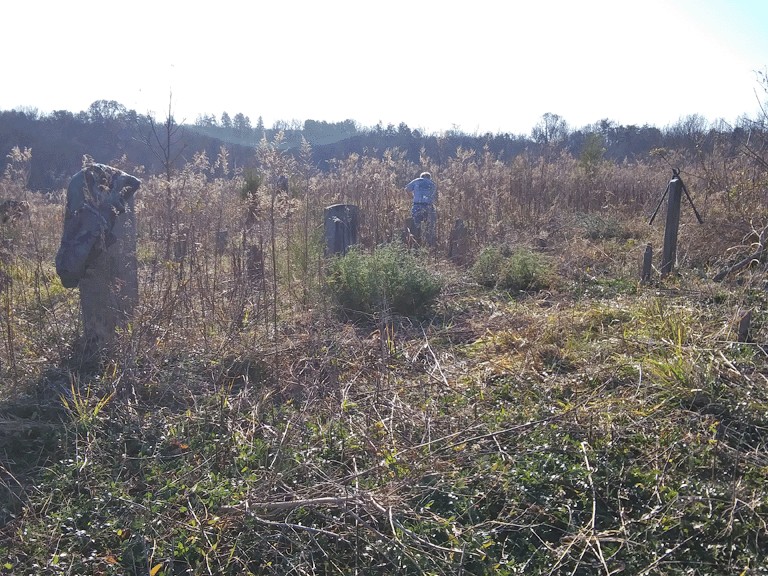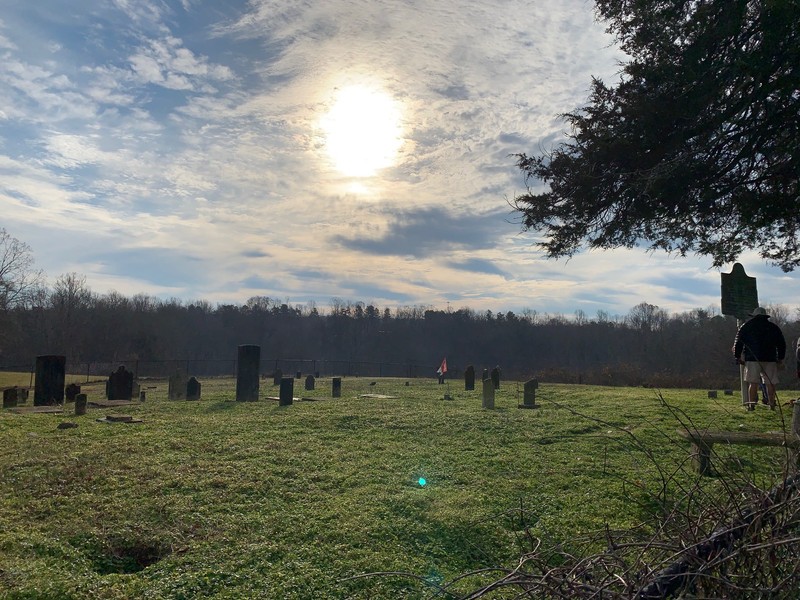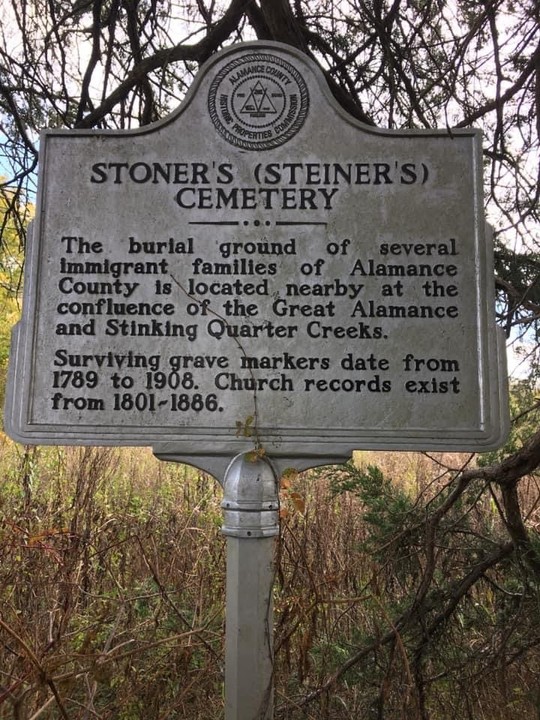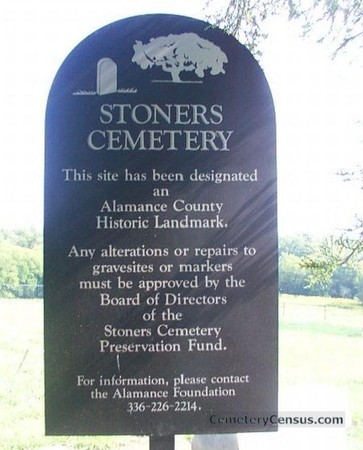Stoner's Cemetery of the German Reformed Church
Introduction
Text-to-speech Audio
One of the earliest churches established by German immigrants in Orange County, North Carolina, was located here- southeast of Burlington alongside present-day Bellemont-Mt Herman Road. The church was abandoned sometime just prior to the 20th century. The cemetery had fallen into extreme disrepair but has recently been cleared of debris and the headstones cleaned, and archaeological research indicates the cemetery was located at the site of a substantial Native American village.The cemetery is now within Alamance County which was formed from part of Orange County.
Images
Condition of Stoner's Cemetery before clean-up efforts began.

Stoner's Cemetery mid-repair.

Alamance County Historic Property Marker

Stoner's Cemetery marker with contact information.

Backstory and Context
Text-to-speech Audio
Many German immigrants entered America and took up residence in Berks County, Pennsylvania. Beginning in the mid-1700s the area around Stinking Quarter Creek saw an influx of these adventurers into the area. Once they established themselves they began setting our locations of worship. Stoner's Church was one of the earliest based on available documentation. The original church, established prior to 1800, sat atop a ridge at the confluence of the Alamance and Stinking Quarter Creeks. During the 1880s a second church was built on the other side of Bellemont-Mt Herman Road. The cemetery is at the location of the original church and is surrounded by a fence. The grounds are being maintained by descendants of those buried within the fence as well as by local residents. A non-profit has recently been created to facilitate continued maintenance of the grounds. The Daughters of the American Revolution association have cleaned the tombstones and plan to rededicate the cemetery sometime during 2021.
The cemetery is the resting place of several Revolutionary War soldiers and some of their gravestones have been replaced with newer models. Resting among the Patriots is one person who fought on the other side during the American Revolution. Jacob Graves was a resident of the Stinking Quarter area who was part of a Loyalist Militia that suffered defeat at a battle known as Pyle's Defeat. This battle was fought a few miles north of Stoner's Cemetery. It is interesting to find a Tory intermingled with Patriots. Jacob died in 1820 so it is possible that bad feelings had long since passed. However, Jacob was involved in an incident at a nearby residence where he shot a Patriot militia colonel who at least one person buried at Stoner's served under.
Several churches experienced congregational splits during the Regulator movement in the early 1770s in the Backcountry of North Carolina. The Regulator Movement was part of an effort to resist unfair treatment at the hands of local officials. The movement was not affiliated with the events of the American Revolution, but many claim otherwise.
Alamance Battleground is where the regulator movement ended through armed conflict with militia under North Carolina Governor Tryon. the Alamance Battleground has an entry on The Clio and provides in-depth information and context for the regulator movement. Most of the information about splits within churches has been obtained through exhaustive research by Mark Chilton, the elected Register of Deeds for Orange County. His research on the matter is extensive and is part of a future publication. As such, detailed information and theories concerning the conflict that existed between adherents to the German Reformed Churches and Lutheran Churches along the Stinking Quarter Creek will be added post-publication of Chilton's work. What is important to know is that Stoner's Church and its congregants played a key role in shaping community relations in the area during the late 18th and early 19th centuries.
The fence around the cemetery was thought but contain all burials on the ridge. However, archaeological investigations during the 1990s revealed the presence of several burials outside the perimeter. The site has been fenced for as long as oral history can trace. It is not known why unmarked burials exist apart from others. One theory is that these burials never had grave markers and those erecting the fence had no way of knowing these graves existed. Records exist indicating the church congregation included African Americans, yet no tombstones are present for African Americans. Because of this, a second theory is that the unmarked burials outside the fence are African American members of the congregation.
While current work to rehabilitate the cemetery has been undertaken by volunteers, deeds at the Alamance County Register of Deeds office indicate that during previous transfers of ownership, new owners accepted responsibility for the cemetery's upkeep at their own expense. The cemetery was designated a County Historic Property in 1999. The marker sits within the cemetery fence which is not visible from the nearest public road. Another marker at the cemetery provides contact for the cemetery through the Alamance Foundation. The cemetery sits on private property and anyone wishing to visit is encouraged to contact the Alamance Foundation for current accessibility options
Sources
Ellis, Mary. Stoner's/Steiner's Cemetery, Web Pages of Mary Ellis. August 14th 2007. Accessed May 14th 2021. https://sites.rootsweb.com/~mwellis/stoner.
Stine, Linda France. 1998. Investigations at Historic Stoner's Cemetery (31AM174, 174**).
Alamance County Deed Book 8 Page 259. Grantee: Trustees of Stoner's Church Grantor: Milton Loy
Alamance County Deed Book 8 Page 293 Grantee: Trustees of Stoner's Church Grantor: Milton loy
Roosevelt, Theodore. The Winning of the West: From the Alleghanies to the Mississippi, 1777-1783. Volume 2. New York, New York. Firework, 1919.
Kristen Albright Fearn
Kristen Albright Fearn
Kristen Albright Fearn
https://cemeterycensus.com/nc/alam/cem041.htm
